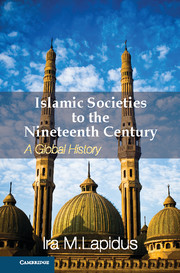Book contents
- Frontmatter
- Contents
- List of Illustrations
- List of Figures
- List of Maps
- List of Tables
- Preface
- Acknowledgments
- Acknowledgments to the first edition of A History of Islamic Societies
- Acknowledgments to the second edition of A History of Islamic Societies
- Publisher's Preface
- Introduction to Islamic Societies
- Part I The Beginnings of Islamic Civilizations
- Part II From Islamic Community to Islamic Society
- Egypt, Iraq, and Iran, 945–C. 1500
- Chapter 20 The Post-ʿAbbasid Middle Eastern State System
- Chapter 21 Muslim Communities and Middle Eastern Societies: 1000–1500 CE
- Chapter 22 The Collective Ideal
- Chapter 23 The Personal Ethic
- Chapter 24 Conclusion: Middle Eastern Islamic Patterns
- Part III The Global Expansion of Islam from the Seventh to the Nineteenth Centuries
- Glossary
- Bibliography
- Annotated Bibliography from A History of Islamic Societies, 2nd Edition
- Index
Chapter 21 - Muslim Communities and Middle Eastern Societies: 1000–1500 CE
Published online by Cambridge University Press: 05 February 2013
- Frontmatter
- Contents
- List of Illustrations
- List of Figures
- List of Maps
- List of Tables
- Preface
- Acknowledgments
- Acknowledgments to the first edition of A History of Islamic Societies
- Acknowledgments to the second edition of A History of Islamic Societies
- Publisher's Preface
- Introduction to Islamic Societies
- Part I The Beginnings of Islamic Civilizations
- Part II From Islamic Community to Islamic Society
- Egypt, Iraq, and Iran, 945–C. 1500
- Chapter 20 The Post-ʿAbbasid Middle Eastern State System
- Chapter 21 Muslim Communities and Middle Eastern Societies: 1000–1500 CE
- Chapter 22 The Collective Ideal
- Chapter 23 The Personal Ethic
- Chapter 24 Conclusion: Middle Eastern Islamic Patterns
- Part III The Global Expansion of Islam from the Seventh to the Nineteenth Centuries
- Glossary
- Bibliography
- Annotated Bibliography from A History of Islamic Societies, 2nd Edition
- Index
Summary
In this period we have more abundant source materials on the community life not only of Baghdad but of many Middle Eastern cities. In this era, the town populations included four main strata: the military elites and their administrative adjuncts, as well as the notability defined by religious learning connected through family ties to the landowning, bureaucratic, and merchant elites; the common people – tradesmen, peddlers, craftsmen in both luxury and ordinary trades; and the lumpen proletariat, an underworld of illicit entertainers such as prostitutes, dancers, wine sellers, and cock fighters; and finally menial workers (especially in despised trades such as tanning, scavenging, and waste removal) and beggars, vagabonds, drifters, migrants, and refugees. These, however, were not amorphous masses. They were organized into a variety of communities, including families, quarters, markets, and religious associations.
Women and Family: Ideology versus Reality (co-author, Lena Salaymeh)
In the early Islamic era (roughly from the seventh to the tenth centuries), our sources for women in society are meager. Chronicles and poetry primarily depict women in the caliphal court, but not in everyday life; legal sources communicate the expectations of jurists, rather than daily behavior. In the “medieval” era (roughly from the eleventh through the fifteenth centuries), although our sources are still limited, we can broadly reconstruct the lives of women as they function in the politics, economics, and social life of their communities. However, most of our sources come from Egypt and Syria and therefore do not represent the full geographic scope of medieval Islamic societies.
- Type
- Chapter
- Information
- Islamic Societies to the Nineteenth CenturyA Global History, pp. 264 - 292Publisher: Cambridge University PressPrint publication year: 2012



